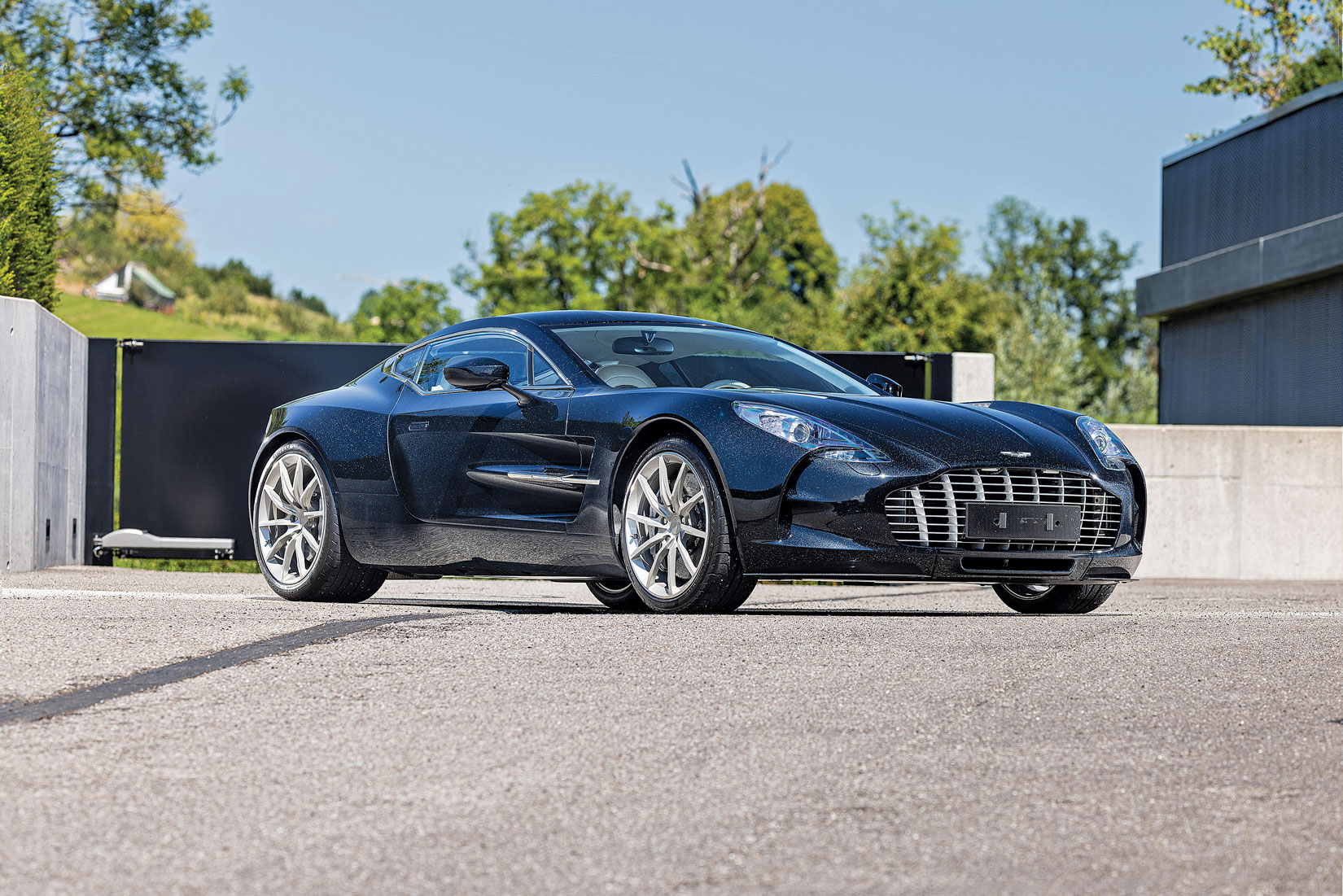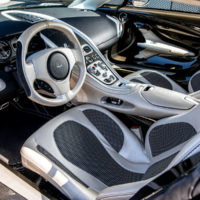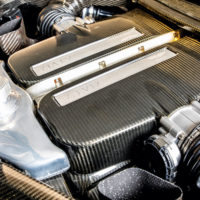The late 2000s marked a period of rediscovery for Aston Martin, with new backing and bold ideas. After a decade-and-a-half under the leadership of Ford, the famous British marque was acquired by a consortium led by Prodrive’s Dave Richards in March 2007. The One-77 was revealed — partially covered, as a non-running prototype — at the 2008 Paris Motor Show.
Under the guidance of then-CEO Dr. Ulrich Bez, the One-77 instantly made headlines. Aston Martin announced that its newest endeavor — with the allure and daring vision of a concept car that would typically be too fanciful for roadgoing production — was indeed available to buy, but would cost as much as £1,000,000. The Aston Martin hierarchy signaled a clear message of intent, framing its desired trajectory to return to the company’s roots of building boutique speed machines.
A 7.3-liter development of Aston Martin’s acclaimed V12, specially reworked by race engineers at Cosworth, would spearhead the raft of exciting, newly announced performance details. The free-revving V12 was rated with factory figures of 750 horsepower and 553 lb-ft of torque, making the One-77 the most powerful naturally aspirated roadgoing car in the world at launch.
This example, numbered 65 of just 77 built, was manufactured in 2011 in left-hand-drive configuration. Owing to its consistently low odometer readings throughout its life, the One-77 received its 16,000 km and 24,000 km services at the same time, when it had covered just 1,077 km. At the time of cataloging, the odometer reads only 1,785 km.
SCM Analysis
Detailing
| Vehicle: | 2011 Aston Martin One-77 |
| Years Produced: | 2009–12 |
| Number Produced: | 77 (plus 1 prototype) |
| Chassis Number Location: | Passenger’s side firewall |
| Engine Number Location: | Front of engine, left cylinder bank |
| Club Info: | Aston Martin Owners Club North America |
| Website: | http://www.amocna.org |
| Alternatives: | 2005–15 Bugatti Veyron, 2015–17 Ferrari F12tdf, 1999–2019 Pagani Zonda |
This car, Lot 106, sold for $1,899,081 (CHF 1,825,000), including buyer’s premium, at RM Sotheby’s St. Moritz, CHE, sale, on September 9, 2022.
A million smackaroos is a big ask in any economy, let alone the turbulent wake of the 2008 financial meltdown. But the Aston Martin One-77’s bona fides were compelling enough to sell all 77 examples, as well as one pre-production example that was thrown into the mix. Bez was cagey about the launch, famously banning journalists from driving his baby so his rosy picture couldn’t be spoiled. But what a portrait it was, a master class in formulating a sense of occasion on four wheels.
The designer’s view
“The whole intention was to create something collectible,” Aston design boss Marek Reichman tells SCM. “People often ask me, ‘What’s your favorite Aston Martin you’ve designed?’ I think One-77 has to be right up there. Its significance is important because it was really the first car that was done through independence.”
The project required serious engineering, including creating a true front-mid-engine V12 configuration, lowering the center of gravity significantly, introducing a new suspension layout, and the labor-intensive nature of body panels shaped via hand-formed aluminum with side mirrors that appear to grow from sheet metal. Despite the exacting process, Reichman also reveals a bit of bohemian spirit that touched the product planning.
“It could have been 75 or 77 [examples], but we decided on 77 because it sounded better when you say it,” he recalls. “Everything we did was to give it an air of specialty, of uniqueness.”
The project marked Aston Martin’s first partnership with carbon-tub builder Multimatic, which is currently collaborating on Aston’s upcoming Valkyrie. “The One-77 was such a seminal moment for us to understand the technology of carbon fiber, and we’ve since done numerous cars based on that philosophy of thinking,” says Reichman. “It also started the design language we see today, all the way through to the DB11.”
While some pundits can’t distinguish the One-77 from other Astons because its cues trickled down to subsequent models, Reichman says he’d happily “…lend them my glasses” in order to recognize its at a local Cars & Coffee. “I think you have to see it in context next to another Aston Martin; it has the biggest grille we’d ever done, a laser-cut, hand-made grille which was akin to the whole ethos of this car: a marriage of high tech and craft.”
The collector’s view
Though skeptics are out there, one ardent appreciator is collector James Kramer (ArtVandelay on Instagram), whose attention was first caught by the One-77 nearly a decade ago. “It was compelling to me, and I could never find one,” he says, adding that when his wife and daughter spotted one at Monterey Car Week and he didn’t, further fuel was added to the fire.
In 2020, he finally acquired a unique example. “Of the 10 One-77 development cars, one became the Vulcan prototype, one became the Victor one-off, three were crash tested, three ended up unfinished prototypes, and one was a marketing car.” Kramer says that after accumulating some 40,000 kilometers, the marketing example returned to the factory for reconditioning, and was eventually sold to an African collector. Because said collector only owns cars finished in the colors of his country’s flag — white, red and black — he requested it be recommissioned in those hues. When Aston Martin resisted, allegedly citing its provenance, it was sold to Kramer.
Reichman says the automated single-clutch gearbox “shifts like a race car,” and that when driven fast, “the gearbox is fantastic. It’s not designed to reverse in a shopping mall. That’s not what the car is designed for.”
Though the One-77 still makes Kramer’s heart go pitter-patter, he sees the car’s dynamics differently. “Upshifts are super-jerky when cold, and it just jerks and lurches — not pretty, especially if you’re backing it up at a car show. It’s almost embarrassing.”
Kramer’s One-77 bears a license plate that reads “IYKYK,” short for If You Know, You Know, an apt maxim to describe a low-volume flagship that rarely goes up for grabs. Reichman backs up that sentiment. “You see so few of them now, and I do believe people are loath to sell their cars.”
Holding steady
With an initial price of £1 million in 2008 (translating to a dizzying $2.4m today), the One-77 eclipsed the Bugatti Veyron and earned the title of the most expensive new car in the world at the time — no small feat for the company once under the firm thumb of FoMoCo.
Our subject One-77 — serial number 65 — sold for $1.9m. As with most limited-production exotics, its odometer reading was low, with a scant 1,785 km (1,109 miles) at the time of sale. If one were to apply today’s exchange rates to the original £1.1m starting price, the $1.9m price would have marked a notable appreciation. However, as it stands, the figure is closer to the One-77’s original sales price by the time the model became available, as the pound sterling had crashed by 2009 to around 60% of its original value.
Further past results paint a higher-resolution picture that supports the theory of stability, rather than significant growth: In November 2021, a rare one-of-seven “Q Series” One-77 traded hands for CHF 1,720,625, also at RM Sotheby’s St. Moritz auction. Prior to that, only five One-77 auction results have been recorded in the SCM Platinum Auction Database; just two have sold, the most expensive fetching $1.6m in 2019.
Limited interest
As radical as the One-77 seemed at its debut, the adoption of its design language throughout the Aston Martin lineup over the years has slightly softened its shock-and-awe effect — which takes us back to the familiar abbreviation. “It’s probably the most apropos license plate you could have, because Grandma thinks it’s just another Aston Martin, and Joe, who’s somewhat knowledgeable about exotics, isn’t sure.” Not that Reichman isn’t bullish on its potential. “It’s going to be a poster child forever,” he says. “A little bit like how you might argue the first Countach is a poster child for Lamborghini.”
The next generation of enthusiasts catching the Aston Martin One-77 bug seems like an unlikely scenario, given the specificity of its sensibility and its subtle approach within the microcosm of 21st century hypercars. Likelier candidates are V12-powered Ferrari halo cars such as the LaFerrari and Enzo.
In Kramer’s opinion, “The Aston Martin One-77 is similar to a Maserati MC12: The people who love ’em, love ’em, and know they’re special. But there’s a limited pool of people who say they need one and try to find one.” Call this one fairly sold in the current market. ♦
(Introductory description courtesy of RM Sotheby’s.)



